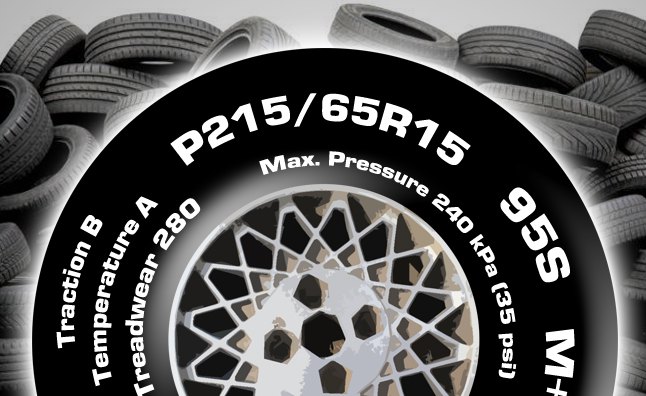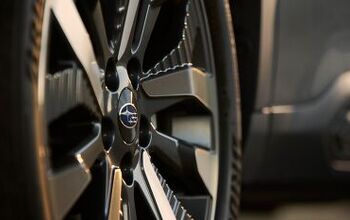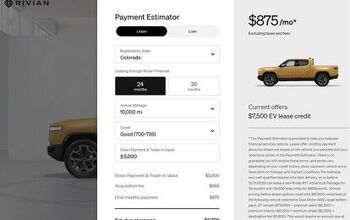How to Read a Tire Sidewall
Buying tires is one thing. Understanding them is another.
No, I’m not talking about the language tires speak when they take corners under full throttle, or when they warm up in the burnout box, or during protests of disgust when the brakes are called upon for a sudden veto.
Rather, I’m talking about all those numbers and letters that appear on the sidewalls of every tire that’s manufactured and sold to the public. In fact, all tires must have certain information molded into them. Some of it’s self-explanatory. The rest is, well, not so much.
So, what does it all mean? Okay, we’ll try to break it down as simply as possible, but don’t be afraid to check out the glossary page if you are having trouble.
For this exercise, we’ll break down a fairly common tire size description – P215/50R17 91V – into its individual components. There’s a lot more information in this nondescript-looking alphanumeric code than you might think.
Let’s start with the size and type, which you can get from the first four characters.
The P at the beginning identifies a tire that has been engineered to U. S. Tire and Rim Association (T&RA) passenger car standards. The lack of a “P” here (as in 215/50R17 for example) indicates a tire that is engineered to European (ETRTO) standards.
While virtually interchangeable, another code used here is “LT”. This indicates a tire that’s intended for use on a light truck or SUV, which have heavier load ratings than passenger cars. Another possibility is “T”, which denotes a temporary or spare tire.
Next is 215, which specifies the width of the tire in millimeters (mm).
The number 50 then denotes the aspect ratio – its height in relation to its width – of the tire. In this example, the height of the sidewall is 50 per cent of the tires width.
You can calculate this figure by multiplying the tires width (215) by its aspect ratio (50) with a decimal placed before it (as in “.50”). Therefore, 215 X .50 = 107.5 is the height of the sidewall in millimeters.
You can then convert this to inches by multiplying the calculated figure by “.03937”. For example, 107.5 X .03937 = 4.23. Multiply the answer by two and add the wheel size like this (4.23 X 2) + 17 = 25.46. All this to figure out the tire stands roughly two-feet tall.
Next, R tells us about the construction of the tire – how its cords are arranged inside the casing and such. In our example, “R” stands for “Radial”.
Up next is the wheel diameter the tire is intended to fit (in inches). In this case, it’s 17.
Now that the first part has been deciphered, we can move on to the second; the service description. Written here as 91V, this tells us two things.
First, 91 indicates the tire’s load index. This is an assigned numerical value used to compare the relative load-carrying capabilities of any given tire. In general, higher numbers indicate greater load carrying capacities.
A standard conversion table is used to decode the maximum load for any given tire. The scale starts at 50 (418.8 pounds) and goes up in single increments to 124 (3,527.5 pounds) though most modern passenger cars and light trucks fall somewhere between 70 and 110. In our example, this tire can be loaded with up to 1,356 pounds.
Second, and just as important, is the speed rating for this tire. This is also an assigned value system. In this case, V indicates this tire is approved for speeds up to 149 mph.
In the past it was acceptable to publish a speed rating symbol “within” the tire size data itself (for example, P215/50VR17). It moved to its current position within the tire service description permanently in 1991. It should be noted that some automotive media outlets still use the former “style” in various popular culture publications.
This chart shows the other speed ratings tires can have.
| Rating | M | N | P | Q | R | S | T | U | H | V | W | Y | Z |
| Max. MPH | 81 | 87 | 93 | 99 | 106 | 112 | 118 | 124 | 130 | 149 | 168 | 186 | >149 |
| Max. KM/H | 130 | 140 | 150 | 160 | 170 | 180 | 190 | 200 | 210 | 240 | 270 | 300 | >240 |
Alright then, moving on.
Yes, your sidewalls tell you more. Lots more in fact.
Even quality assurance can be found here. The Uniform Tire Quality Grading (UTQG) rating applies to three categories – treadwear, traction and temperature – which are tested under controlled conditions and graded to a standardized system.
A major caveat of this system, at present, is that every manufacturer adheres to its own set of standards. With that in mind, the quality ratings are most accurate when comparing tires made by the manufacturer.
Treadwear is the relative measure of how long the tread will take to wear down. A good rule of thumb is that higher numbers are better. A rating of 300, for example, means the tread should last twice as long as a tire with a treadwear rating of 150. The actual rate that tires wear, however, is not fixed and depends on countless factors from surface conditions to maintenance (or lack thereof) and everything between.
Likewise, the traction ratings describe a tire’s ability to stop on wet pavement and concrete. These tests are done in a straight line and provide no information as to a tire’s cornering abilities. There are four ratings manufacturers use – AA, A, B and C – with the AA being the highest rating possible.
Finally, there’s temperature. This grading measures a tire’s ability to withstand and dissipate heat under controlled, indoor lab conditions. Again, every manufacturer is responsible for conducting their own tests. From highest to lowest, temperature resistance is either: A, B or C.
Another important bit of info your tires must have molded into the sidewall is a DOT (Department of Transportation) number – or tire identification number – that assures the user a tire has met certain safety standards. This code is usually 10 to 12 characters long and contains information such as when and where it was made, by which manufacturer, what plant, assembly line and its size.
Maximum pressure is also stated on the tire sidewall. This is different for a tires recommended tire pressure. This number is the maximum cold pressure necessary to carry the maximum load for which the tire is rated.
As per above, the maximum load number tells you the maximum amount of weight a tire can support when cold. Exceeding either or both (max pressure and/or load can result in catastrophic failure of the tire).
Conditions are other labels that tire manufacturers publish on the sidewalls to give more information about the purpose of the tire. For example, the abbreviation “M+S”, would indicate an all-season tire. Likewise, a snowflake and mountain symbol indicates a tire that meets or exceeds snow tire designation specifications.
Your sidewalls tell you even more. But, besides the obligatory safety warning, international compliance codes and notes on the type and construction of the tire itself, this is already more than enough information for the average consumer to digest in one sitting.
More by Shaun Keenan














![How to Read a Tire Sidewall; Latest Installment in Yokohama's Tire Tips Series [video]](https://cdn-fastly.autoguide.com/media/2023/06/07/12388879/how-to-read-a-tire-sidewall-latest-installment-in-yokohama-s-tire-tips-series.jpg?size=350x220)
![Yokohama Offers Tips on Buying SUV and Truck Tires [video]](https://cdn-fastly.autoguide.com/media/2023/06/07/12392071/yokohama-offers-tips-on-buying-suv-and-truck-tires-video.jpg?size=350x220)
















Comments
Join the conversation
Can I put a 245/45 ZR17 on my Trailblazer that has 245/65 R17?